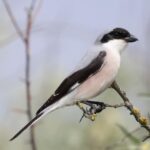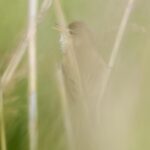A two day special Private Tour, across Monday and Wednesday this week. It was to be two relaxed shorter days of general Norfolk birding, although we could always catch up on some of the less regular species if the opportunity presented itself.
A gentle start to day 1 saw us stopping at Holkham, but not before we had been forced to swerve to avoid two Egyptian Geese in the middle of the main road! The Marsh Harriers were displaying again – we watched the female circling above the trees, before the male flew in and started swooping from side to side, before dropping down into the reeds.
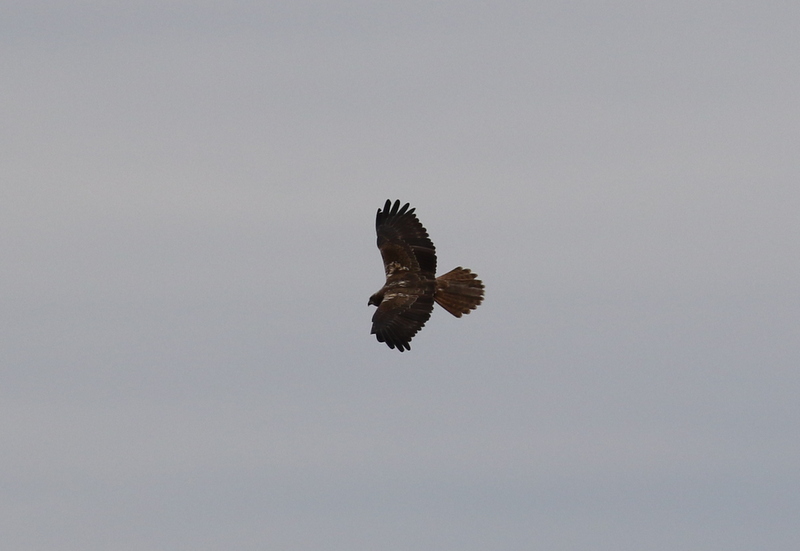 Marsh Harrier – the pair were displaying again today
Marsh Harrier – the pair were displaying again today
Two large white birds half visible in the trees were Spoonbills. We could see their bushy nuchal crests flapping in the breeze and just make out their spoon-shaped bills. One of them did a nice fly round over the grazing marsh for us. The trees were also full of Cormorants which are busy nesting at the moment.
There were plenty of Greylag Geese and Egyptian Geese out on the marshes, and the odd Canada Goose too. But over on the old fort, we could see some lingering Pink-footed Geese as well, at least 15 today. There are always a few sick or injured birds which stay for the summer, but there are some healthy ones still here too which should soon be on their way back to Iceland. Through the scope, we could see their dark heads and small, mostly dark bills with a pink band around.
We could just make out lots of hirundines swooping around over the grass – mostly House Martins, plus a few Swallows – though they were hard to pick out against the vegetation in the distance, until a couple flew up higher into the sky.
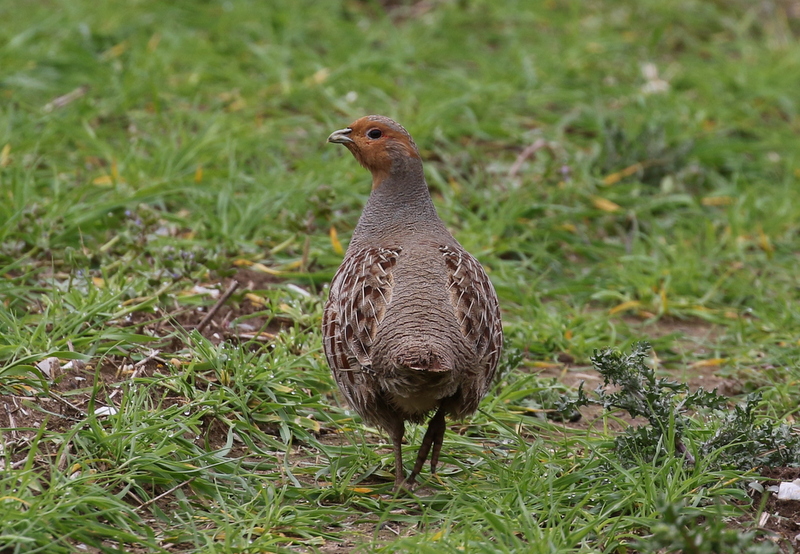 Grey Partridge – we saw several at Choseley today
Grey Partridge – we saw several at Choseley today
Our next destination was Titchwell, but we made a short diversion on the way there, round the back via Choseley, to try to pick up some farmland birds. Our first stop produced a smart Grey Partridge lurking on the edge of a field, tucked in behind a hedge. It was a bit breezy up on the ridge, and cold in the wind, so we had a quick drive round to see if we could find anything else. The hedges were pretty quiet and the birds were obviously keeping themselves tucked down. There was no sign of the Ring Ouzels here unfortunately – they may have moved on or just found somewhere sheltered – and a quick walk along the footpath was similarly unproductive, apart from a pair of Linnets. We decided to move on to Titchwell.
The main car park was already full when we arrived, despite it being a Monday, cool and cloudy. We parked in the overflow car park and had a quick walk round – both Chiffchaff and Blackcap were singing from the sallows, both species now back for the summer. Up to the visitor centre and the feeders were rather quiet – just a few Chaffinches and tits coming in to feed – so we didn’t linger. We could hear a Siskin singing from the trees, but couldn’t see it, and we couldn’t find the Water Rail in the ditch when we went past at this point either.
We swung round via Meadow Trail. There were several Willow Warblers and Chiffchaffs singing from the willows and we managed to get good views of both these two very similar species. A female Blackcap was flitting around in the reeds by the dipping pool. A pair of Bullfinches disappeared off over the tops of the trees as we approached.
A quick visit to Fen Hide, and a single drake Red-crested Pochard was out on the water, but flew off just as we sat down. We heard a Bearded Tit ‘ping’ but when it flew off across the reeds it was too quick for everyone to see. A Wren feeding down low on the edge of the cut reeds was behaving just like a Bearded Tit should! Out over the reedbed, there were lots of House Martins hawking for insects, and the odd Sand Martin in with them. There had obviously been a decent arrival of hirundines this morning.
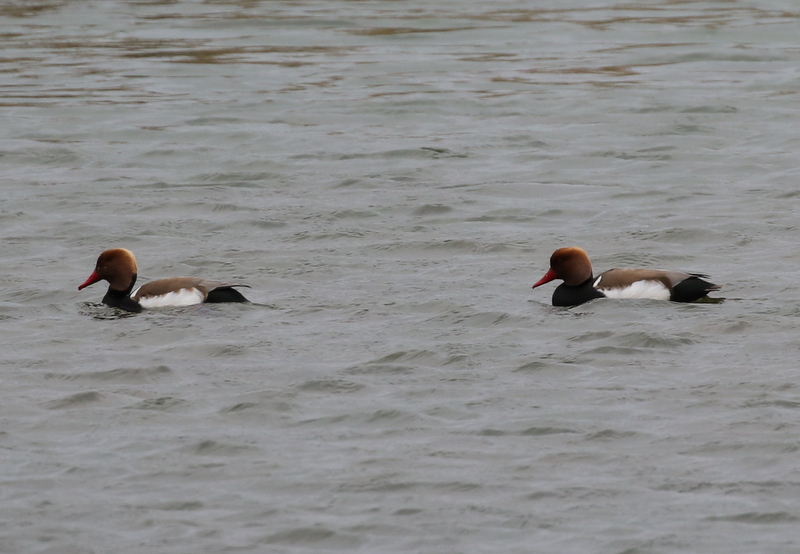 Red-crested Pochard – three drakes were on Patsy’s Reedbed
Red-crested Pochard – three drakes were on Patsy’s Reedbed
There was a decent selection of ducks on Patsy’s Reedbed. Three drake Red-crested Pochard were busy feeding, a small group of Tufted Duck and Pochard were asleep on the near bank, and we could see a few Gadwall, Teal and Shoveler too. A couple of Little Grebes were diving constantly. Over the reeds beyond, a couple of Marsh Harriers were circling. As it was getting near to lunchtime, we decided to head back to the car for an early lunch, before exploring the rest of the reserve.
After lunch, we walked back out to the Visitor Centre. There was still not much on the feeders, but we could hear a Siskin singing in the trees and managed to get it in the scope. Another look in the ditch by the main path failed to produce a Water Rail again – surely they couldn’t have disappeared?
 Siskin – this male was singing by the Visitor Centre
Siskin – this male was singing by the Visitor Centre
The grazing marsh ‘pool’ was rather exposed to the cold wind. Still, there were a few wagtails out there today. A closer look revealed at least four White Wagtails, as well as a few of their close cousins the Pied Wagtails, but no sign of any pipits here today. A lone Great Crested Grebe was at the back of the reedbed pool, which also held a selection of ducks – Red-crested Pochard, Common Pochard and Tufted Duck.
A particular target species was Avocet and Titchwell is a great place to see them up close. We popped in to Island Hide and were treated to fantastic views of them just in front of the hide. It was great to watch them feeding, sweeping their bills from side to side through the shallows.
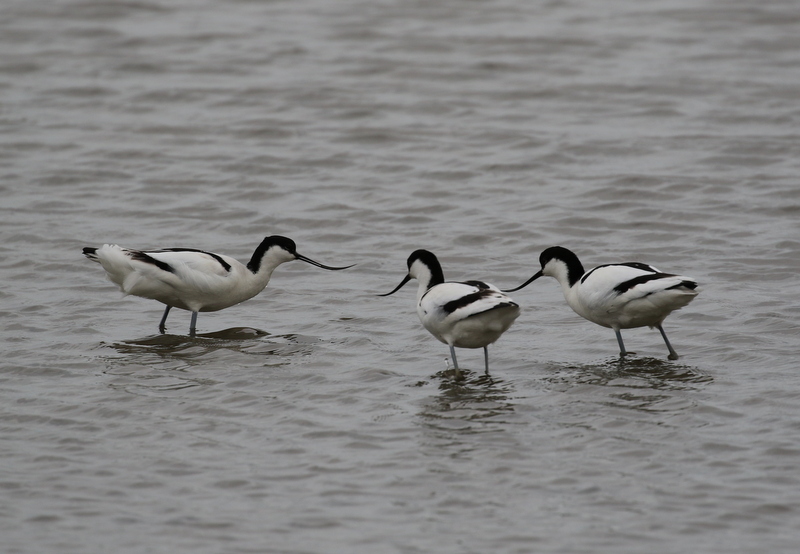
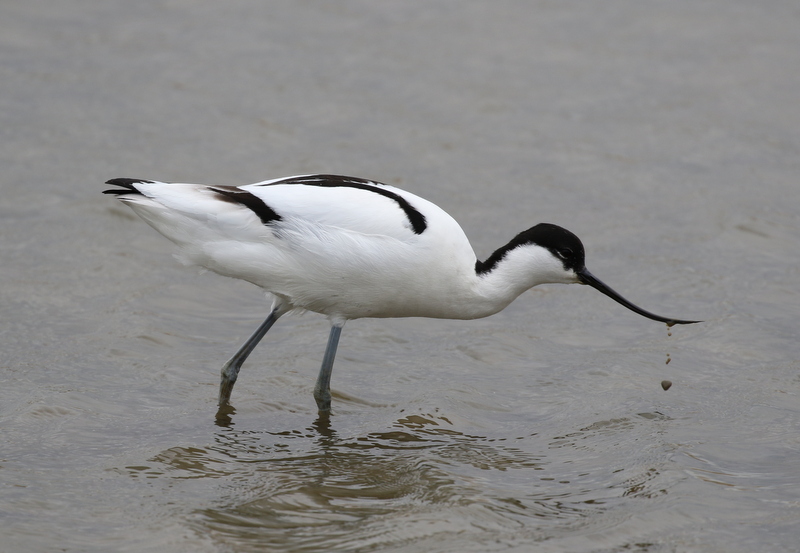 Avocets – great views from Island Hide today
Avocets – great views from Island Hide today
There were also several Teal in front of the hide. Mostly paired up now, the drakes are looking particularly smart. Numbers of duck are well down from the peak of the winter now, as many have departed on their journey north to breed, but a scattering of Gadwall, Shoveler and Mallard remain.
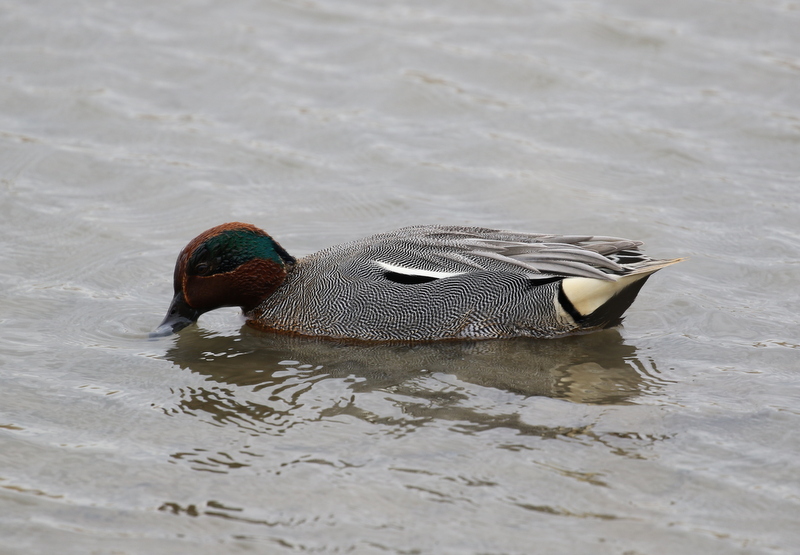 Teal – a smart drake
Teal – a smart drake
We could hear Bearded Tits calling from the reeds, and caught the odd glimpse of a bird zooming off over the reeds. Eventually, we all managed to get on to one which made a quite lengthy cross-reed journey, before dropping back in out of view.
The water levels are going down now on the freshmarsh, and it is looking great for waders, but it still seemed a bit quiet here wader-wise, apart from the Avocets. There was a nice flock of roosting Black-tailed Godwits and a single Bar-tailed Godwit. When we got round to Parrinder Hide, the Bar-tailed Godwit had joined with a single Black-tailed Godwit, a Knot which must have just flown in, and a lone Oystercatcher – which made for an interesting little flock.
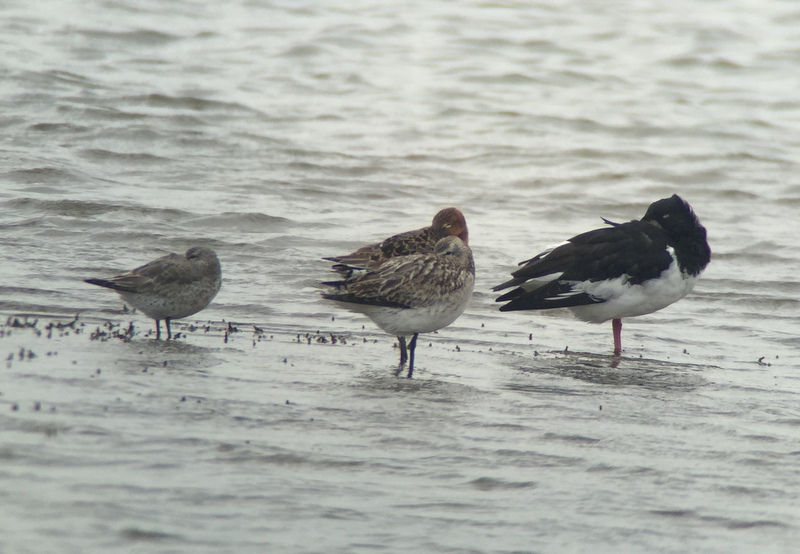 Waders – a nice group of Knot, Bar-tailed & Black-tailed Godwit, & Oystercatcher
Waders – a nice group of Knot, Bar-tailed & Black-tailed Godwit, & Oystercatcher
A Little Ringed Plover flew in and landed on the island in front of the hide. We could see the fine, dark bill and golden-yellow eyering. A careful scan then revealed a second, very well camouflaged against the mud. A single Turnstone was feeding round the edge of the big island, tucked in behind the new Avocet nest protection fence.
 Little Ringed Plover – 1 of 2 on the freshmarsh
Little Ringed Plover – 1 of 2 on the freshmarsh
There are still quite a few Brent Geese at the moment, and they were commuting back and forth between the saltmarsh where they were grazing and the freshmarsh for a wash and brush-up.
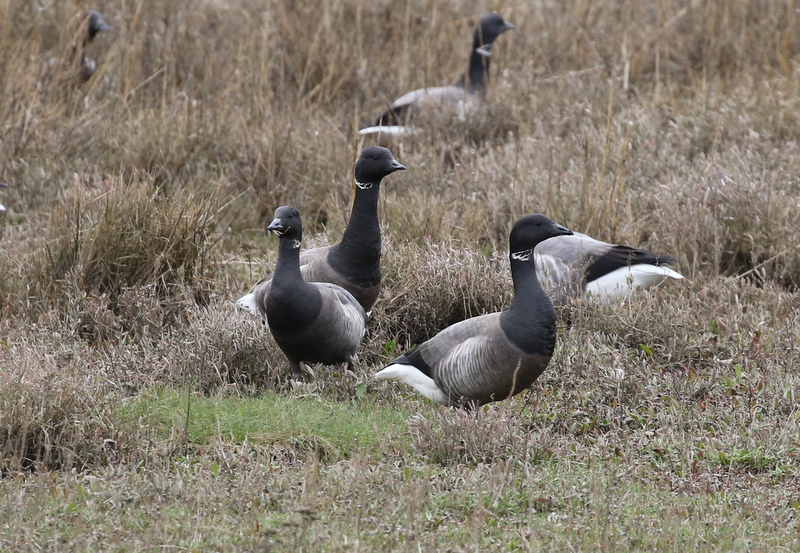 Brent Geese – quite a few still here, mostly on the saltmarsh
Brent Geese – quite a few still here, mostly on the saltmarsh
The Volunteer Marsh was rather quiet, apart from a few Redshank along the sides of the furthest tidal channel, and there was not much new to see on the Tidal Pools either, apart from a single Grey Plover.
Out on the beach, the tide was coming in and the shellfish beds were already covered by the sea. There were a few waders still out on the sand, being pushed ever higher – a few Grey Plover, a single Turnstone and a couple of little groups of silvery grey Sanderling running around like clockwork toys. Looking out to sea, all seemed quiet at first, until we found a couple of Great Crested Grebes and a small raft of Common Scoter.
It was a bit fresh out on the beach, so we didn’t hang around too long. On the way back, another Little Ringed Plover appeared on the Tidal Pools. We stopped to admire a very smart pair of Shelduck by the path on the Volunteer Marsh. A Lesser Black-backed Gull, sporting bright yellow legs and feet, had appeared on the Freshmarsh. And there was now a pair of Great Crested Grebes on the reedbed pool and even better, they were displaying!
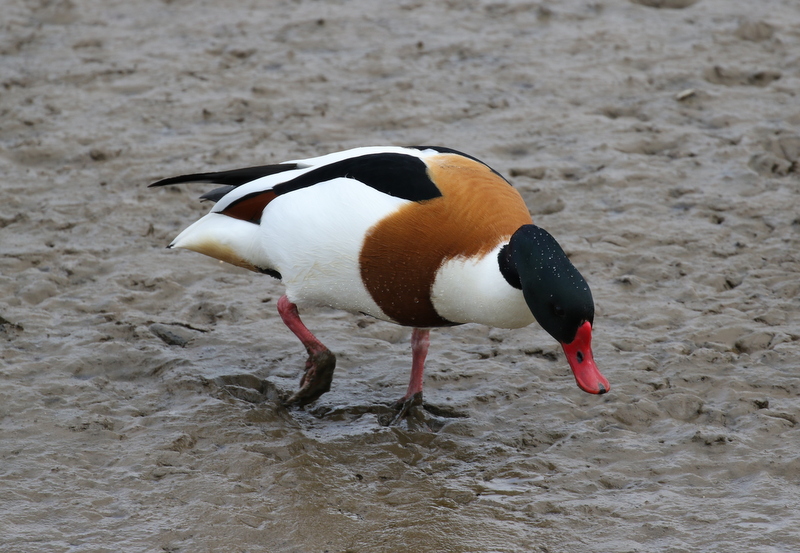 Shelduck – a pair were by the path
Shelduck – a pair were by the path
We still couldn’t find any pipits on the grazing marsh ‘pool’ but we did manage to find a Water Rail or two. We found the female first, feeding quietly in the water in the bottom of the ditch. Then she was joined by the male, and the two of them fed together for a few seconds, before he disappeared off again. It was great to see the two of them side by side.
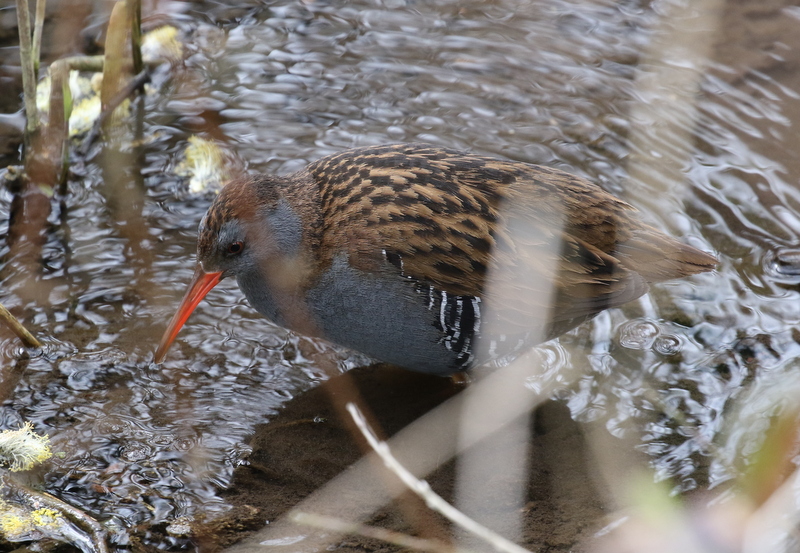
 Water Rails – hard to see in the ditch
Water Rails – hard to see in the ditch
We were treated to great views of the Water Rails, and then it was time to call an end to Day 1.
Day 2 saw us starting from Lady Anne’s Drive to walk west. A few Teal were sleeping around the pools alongside the road. We could also see several Shelduck and a single Snipe feeding on the mud.
As we started to walk west along the path on the inland side of the pines, we could hear lots of warblers singing – Blackcap, Willow Warbler and Chiffchaff. It was to be a real theme of the morning, with warblers singing all the way. From the bushes in the reeds we added Sedge Warbler to the list and in the scrubbier areas we heard a couple of Lesser Whitethroat. At one point we could hear all five warblers singing at once from where we were standing.
There were also the usual tits in the trees – Blue Tits, Great Tits, Coal Tits and Long-tailed Tits. Jays called and one flew up into a poplar by the path briefly. A Treecreeper was singing and we managed to see it climbing up a bare trunk, stopping occasionally to deliver another burst of song.
While we were on our way through the trees, news came through of a party of six Cranes seen flying west from Cley. With a good chance they would come over Holkham too, we walked quickly up to Salts Hole where it was more open. We stood here for a while and scanned the sky. There were lots of raptors up – Buzzards and Marsh Harriers. A Sparrowhawk circled up too. But there was no sign of any Cranes and it looked like they must have gone past before we made it out of the trees.
A Firecrest had been singing earlier just a little way back along the track, so we walked back into the trees the way we had just come. We had only waited a few seconds when we heard it singing further back in the pines. It would be impossible to find in there, but fortunately it flew forwards into the holm oaks by the track. We watched it flitting around in the trees, though it was hard to get onto – Firecrests rarely stay still for long.
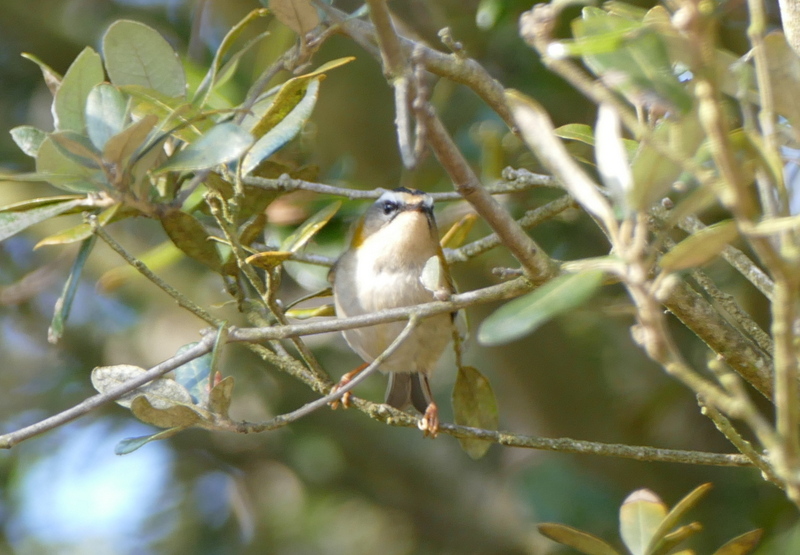 Firecrest – this photo taken a few weeks ago here
Firecrest – this photo taken a few weeks ago here
We heard aggravated calls above us and looked up to see a Herring Gull and Peregrine chasing each other. It was hard to tell who was chasing whom, and we quickly lost sight of them over the trees.
Back on our way west, we had just got past Salts Hole when we received news that the Cranes had been seen again circling over Burnham Overy only five minutes earlier. They had somehow got past us, presumably when we were in the trees. We found a suitable vantage point and scanned the sky to the west, but we could not see anything at first. It really felt like we had missed them. Then finally we picked up two Cranes circling, very high and very distant. They were not much more than dots in sky, even through binoculars. Then we found the other four too, circling lower down and all six gradually came back together. Through the scope we could just make out the shape, and get a glint of grey wing coverts as they turned and caught the sun. At least we had seen them, but they were not great views.
We carried on west, straight out to the dunes. Two adult Mediterranean Gulls flew past us calling on the way. We knew exactly where the Ring Ouzels had been in the last few days and, even though several others had failed to see them find them, sure enough they flew out of their usual bushes. One at a time – first one, then a second, followed by a third and a fourth. We saw where they landed in some more bushes and walked round into the dunes to a convenient vantage point. They stayed hidden for several minutes but eventually came out briefly onto the grass, just long enough to get a smart male in scope, showing off the white gorget on his breast. Then they flew off across the dunes.
 Ring Ouzel – one of the birds here a week ago
Ring Ouzel – one of the birds here a week ago
As we walked back towards the main path, the Ring Ouzels suddenly appeared again, flying back in to the bushes where they had been first off. But there were lots of people walking in the dunes today, and they were promptly flushed once more. This time they flew off to the other side of the fence and dropped down out of sight behind the dunes. We had a quick look further west, in the next dune slack, but there was no sign of any Wheatears here today. Then we had a request to head back for lunch.
We got back almost to the pines when we heard birds calling. It sounded like Cranes but surely it couldn’t be? The six Cranes from earlier had been seen going much further west, over Titchwell before heading out to sea over Holme. Distant at first, they progressively got a little louder. Then three Cranes appeared out of the sky, followed by three more. They circled over the grazing marshes in front of us for a minute or two, before drifting off back east. They had obviously got to the Wash and not fancied the sea crossing, so turned back. It was great that they did – we got much better views this time, through the scope.
 Cranes – first three reappeared
Cranes – first three reappeared
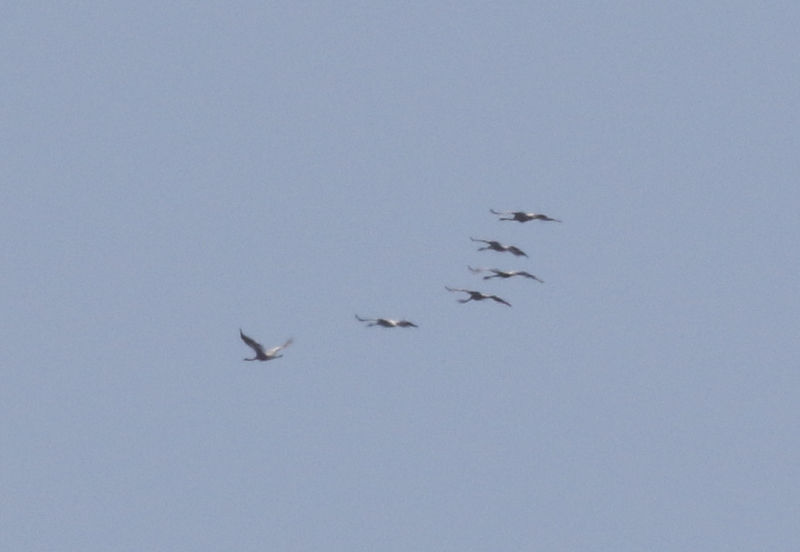 Cranes – then all six together headed off back east
Cranes – then all six together headed off back east
On the way, we stopped in at Joe Jordan Hide briefly. There were several Spoonbills on the pool in front, but they were mostly tucked down behind the reeds along the near edge. We did manage to see a couple preening through a gap in the vegetation. Two Red Kites were circling over the marshes beyond. Then it was time to head back for what was now a late lunch.
After the distraction of the Cranes in particular, we were running later than expected, so there was not really enough time this afternoon on a short day to go far. We drove round inland via some nearby farmland, where several Wheatears in a stoney field were a nice surprise. Then we made our way down to Burnham Norton. There had been a Green-winged Teal here yesterday, but some local birders were just coming back from a thorough search of the area and told us there was no sign of it today. We had thought we might walk round here anyway, but they informed us that the paths were very wet underfoot, so we moved on.
Back past Burnham Overy Staithe, we had a quick walk out across the fields to the seawall. A Yellowhammer and another Lesser Whitethroat were singing from the bushes beside the path. But there were no Sedge Warblers singing along here this afternoon, where they are normally fairly numerous. The wind had picked up now and it was a little cool out in the open, so perhaps they had decided to hunker down.
Out in the fields, there were lots of Redshanks and Lapwing. A careful scan produced a lone drake Wigeon on one of the pools – most of the birds which spent the winter have now departed on their way back to Russia to breed.There were a few geese out on the grazing marshes too. Mostly Greylags and Egyptian Geese, plus a handful of Brent Geese (most of the Brent Geese prefer to feed out the saltmarsh at this time of year). From up on the seawall we managed to find a few Pink-footed Geese still. Like with the Wigeon, most of the ones which spent the winter here have long since departed, in the case of the Pinkfeet back to Iceland. We had a closer view of these than the ones we had seen yesterday, noting the pink bill band and even the pink legs, though hard to see in the long grass.
A single Spoonbill flew low over the grazing marshes and looked like it might be dropping down onto the pools, but carried on west. Later, we watched two more Spoonbills coming from the direction of Holkham. They flew steadily west, out over the seawall, and seemed to go down in harbour channel back towards Overy Staithe. We walked that way along the path but, by the time we got round, there was no sign of them there. Just when we thought our luck was out, they circled up again from the saltmarsh just beyond the harbour. They seemed unsure of where they wanted to go, but after circling for a second or two, flew straight back past us. Cracking views!
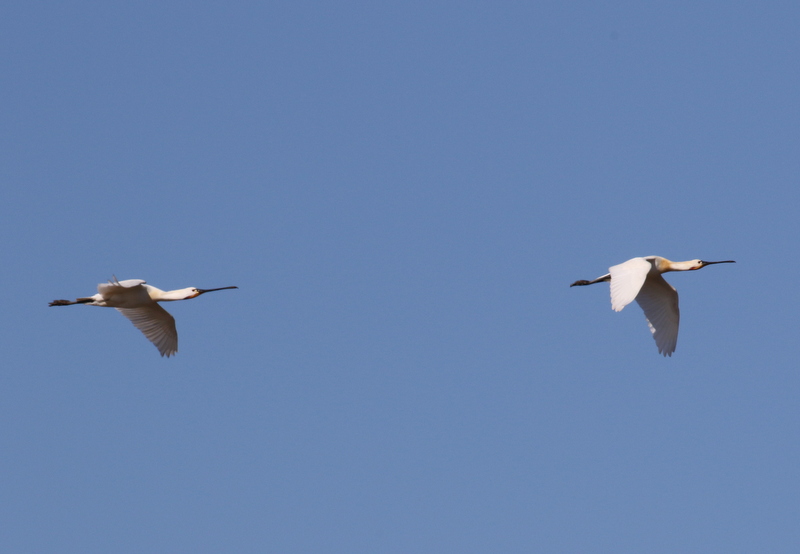
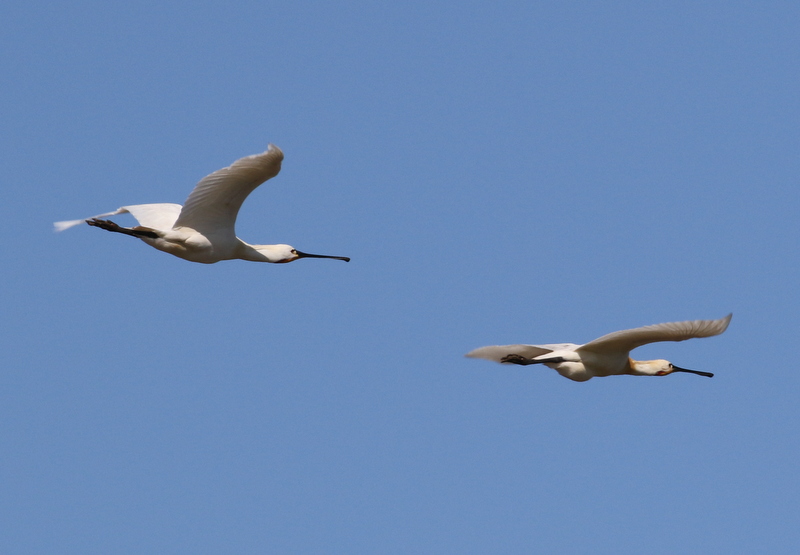 Spoonbills – flew back past us from the saltmarsh
Spoonbills – flew back past us from the saltmarsh
There were a few waders down on the mud below the seawall, on the edge of the saltmarsh. Black-tailed Godwit, Redshank, Avocet and Grey Plover. A single Whimbrel flew across the grazing marsh calling and disappeared over the seawall. It was decidedly cool in the fresh easterly breeze up here on the seawall, and we had a request to head back.
There was just enough time left for a quick visit to the local gull colony. In amongst the hordes of Black-headed Gulls, we picked out a smart pair of Mediterranean Gulls. Side by side with a Black-headed Gull, we could see their darker jet black hoods, more extensive on the back of the head, their heavier, brighter red bills and their pure white wing tips. A Common Gull also flew right past in front of us.
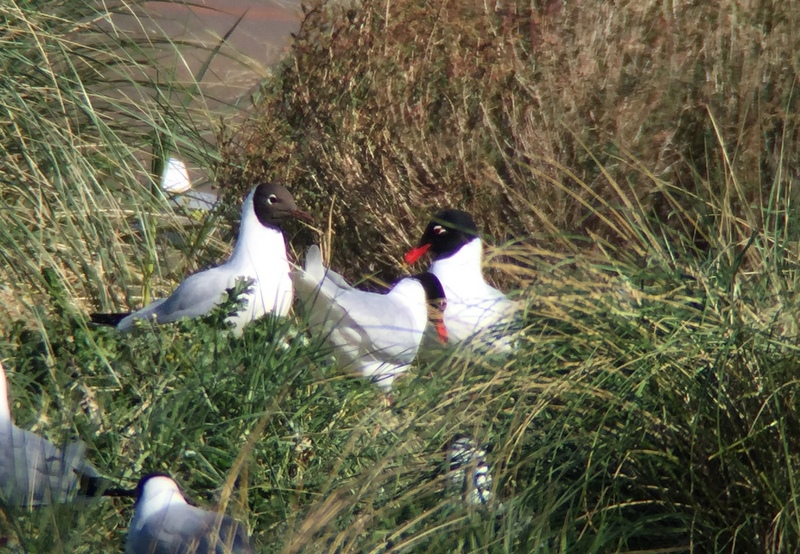 Mediterranean Gulls – with a Black-headed Gull for comparison
Mediterranean Gulls – with a Black-headed Gull for comparison
There were lots of waders on the mud here too and we just had a chance for a quick scan through. Lots of Oystercatchers, a couple of large groups of Turnstone and two Bar-tailed Godwits. Then it was time to head for home.
